|
|
|---|
Farewell, John Barry
Music can make a good movie great, and a great movie legendary. John Barry had the ability to use music to take the films he scored to the next level. Sadly, he died yesterday at the age of 77. In his long career he won 5 Academy Awards and scored 11 James Bond movies. Many credit John Barry with helping the James Bond film series achieve its status as the longest lasting and most profitable one of all time. His work on the scores, as well as the theme songs was integral in setting the tone for the popular titles sequences, as well as the action and romantic scenes.
The brassy, jazzy and sensuous melodies penned by Barry are some of the most recognizable in screen history. The James Bond theme (credited to Monty Norman) was unfinished when John Barry took it and made it iconic with its aggressive twangy guitar. It is no surprise that I have the vast majority of Barry's James Bond music on my iPod, not only because it reminds me of my favorite film series, but because the music is that good. Do I like John Barry because of James Bond, or do I like James Bond because of John Barry? Both. The two are linked forever in cinema history, and even though other great composers worked on Bond films, nobody left a mark like John Barry.
JOHN BARRY'S BEST BOND SCORES
1. ON HER MAJESTY'S SECRET SERVICE
2. GOLDFINGER
3. THUNDERBALL
4. MOONRAKER
5. A VIEW TO A KILL
Labels:
James Bond,
Movies
Meiko Kaji- 梶芽衣子/Zenkyoku Shu (2004)- EAC CD Rip (FLAC)

*sigh*...

Technical Information:
Artist: Meiko Kaji
Album: 梶芽衣子/Zenkyoku Shu: The Best of Meiko Kaji
Year: 2004
Audio Codec(s): FLAC8
Encoding: Lossless
Rip: EAC split tracks
Avg. bitrate: 880 kb/s
Sample rate: 44100 Hz
Bits per sample: 16
Channels: 2
File size: 436 MB
Length: 1:09:18

Tracklisting:
01. Urami Bushi (3:36)
02. Onna no Jyumon (2:54)
03. Shura no Hana (3:52)
04. Yadokari (3:26)
05. Jeans Blues (3:35)
06. Ingabana (4:04)
07. Gincho Wataridori (3:12)
08. Onna Negai Uta (3:37)
09. Betsuni Dottekoto Naishi (2:46)
10. Shuki no Uta (4:09)
11. Akana Gum (3:43)
12. Nokori Bi (3:47)
13. Meinichi (3:24)
14. Umihozuki (3:02)
15. Hune ni Yurarete (2:57)
16. Wakarebanashi nanka (2:29)
17. Ame no Yoru no Anata wa (3:39)
18. Minami Kaze (3:13)
19. Banka (3:58)
20. Meiko no Yume wa Yoru Hiraku (3:54)

Zenkyoku Shu Megaupload Link
Labels:
lossless cd,
meiko kaji,
music
Shunya Itō- 女囚さそり 第41雑居房/Female Convict Scorpion: Jailhouse 41 (1972)- Remastered- DVD5 (NTSC Format)
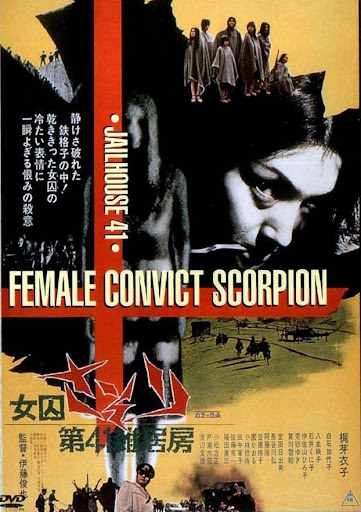
Meiko Kaji...*sigh*.
I bumped into a lossless album of hers a few days back, so I thought it might be a good idea to post one of her films first, in case there are those out there who have no clue as to who the hell she is. The album should be coming up next, unless Carlos decides to throw a grenade into the post.
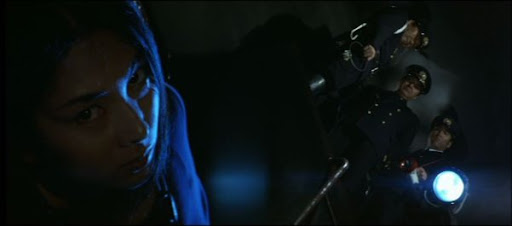
From Jasper Sharp at Midnight Eye:
Debuting in a number of small roles for Nikkatsu under her real name of Masako Ota, the elegant Meiko Kaji first caught the eye of the Japanese public when she took the star role as the leader of a vicious gang of female bikers with five films in the Stray Cat Rock series that ran from 1969 to 1971 (kicking off with Stray Cat Rock: Female Boss / Noraneko Rokku: Onna Bancho, helmed by the director of the flamboyant Black Tight Killers, Yasuharu Hasebe).
The success of these films led to a number of further starring roles - amongst them two films for Joys of Torture director Teruo Ishii, (Ascending Dragon: Gamblers Skin / Nobori Ryu Tekka Hada, 1969 and Blind Woman's Curse / Kaidan Nobori Ryu, 1970) and Yoshio Harada's Melody of Rebellion (Merodee no Hangyaku, 1970) - before she switched studios when Nikkatsu turned their production exclusively over to their Roman Porno line. Her central role in Toei's series of prison actioners Female Convict Scorpion (Joshuu Sasori) as Matsu, better known as Sasori (Scorpion) to her fellow inmates, proved immensely popular and led to one of the most fascinating Japanese serials of the 70s.
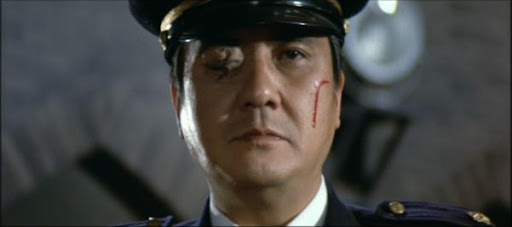
The Golden Decades of Sexploitation saw a plethora of women-in-prison flicks in which the imagined ongoings of bare babes behind bars formed a convenient backdrop into which to slot the requisite number of catfighting, lesbian, torture and communal shower scenes with films from such diverse sources as Hong Kong (Chin Hung Kuei's Bamboo House of Dolls, 1974), the US (Jonathan Demme's Caged Heat, 1974), the Phillipines (War Victims, 1983), and Europe - Spanish sleazemeister Jess Franco directed no fewer than five for the Swiss producer Erwin C. Dietrich between 1975 and 1977!
Don't be mistaken however, the Female Convict series is worlds apart from these sleazy productions, being both far better made, far less exploitative and adopting an almost fantastical approach to the material. In fact this film, episode two of the series, spends very little time inside the prison walls at all, instead focusing on the girls' escape from their warders through a bizarre succession of surreal encounters.
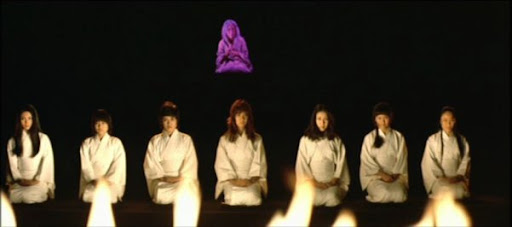
Based on the popular manga series by Tooru Shinohara, director Shunya Ito frames the action of Jailhouse 41 in pure comic strip style. Kaji was apparently unhappy with the original portrayal of the character of Sasori on the page, especially the perpetual stream of obscenities flowing from her mouth, so the script was tailored to allow her to play the role almost silently. The change makes for a surprisingly effective heroine, bringing an exquisite dignity to the character as she tags along aloof from the rest of the group, only entering into the fray when absolutely necessary.
Introduced shackled and bound and bathed in blue light at the bottom of the pit where she has lain for a year, scraping at the ground with a spoon in her mouth before she is hosed down by her wardens and dragged back to rejoin her fellow convicts, Sasori's year in solitary confinement fails to subdue her. Straight away she lunges at the Head Prison Warder's face shattering his spectacles with the sharpened spoon handle, an act which lands her bound to a makeshift crucifix of tree branches surrounded by braying dogs and guards clad in nylon masks as the rest of the rest of female convicts are chained together and put to hard labour. The film really gets underway when the girls break out of the van transferring them to a higher security unit, swathed in black robes as they flee across a village buried under volcanic ash through a string of diverse and increasingly weird episodes.
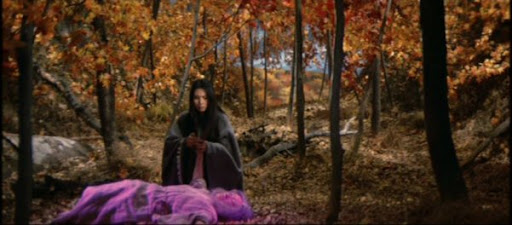
As night falls in a scene where the wanted women hide out in a deserted village, the whole set appears to peel away against a loud crack of thunder to reveal the only inhabitant, a ghostly woman clutching a knife. Later the girls are introduced individually in Kabuki style against a plain black backdrop, a male singer crooning in the background revealing their crimes, which are predominantly against the male sex: this is a world where women rule. Sasori's main rival in the group (played by Kayoko Shiraishi) is a snarling caricature of evil, lifting up her smock to display the scars of when she committed infanticide by stabbing at the unborn foetus nestling in her belly after murdering her husband. After fleeing through an autumnal forest of golds and reds, the gang clash against a busload of rowdy tourists - sexist salarymen who come out of the deal rather the worse off for their behaviour.
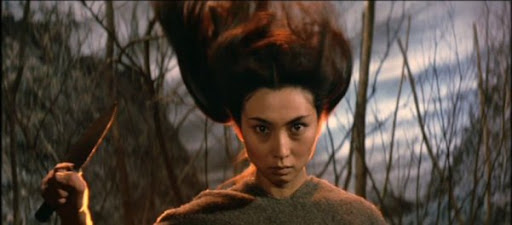
Kaji's lead as Sasori lasted for the first four films in the series, all directed by Ito save the fourth from the aforementioned Hasebe; Female Convict #701- Scorpion (Joshuu 701 Go - Sasori, 1972), Female Convict Scorpion: Jailhouse 41 (Joshuu Sasori - Dai 41 Zakkyobo, 1972), Female Convict Scorpion: Department of Beasts (Joshuu Sasori - Kemono Beya, 1973) and Female Convict Scorpion - #701's Song of Hate (Joshuu Sasori - 701 Go Urami Bushi, 1973). After this Yu Kohira took over directorial duties for two more entries before the series trundled out of steam, ending with New Female Convict - Special Cellblock X (Shin Joshuu Sasori - Tokushubo X, 1977). In 1991, Evil Dead Trap director Toshiharu Ikeda resurrected the character in Female Convict Scorpion: Death Threat (Joshuu Sasori - Satsujin Yokoku). Kaji, in the meantime, went on to star in Lady Snowblood (Shurayukihime) in 1973 and its sequel the following year, Toshiya Fujita's feminisation of the Lone Wolf / Kozure Ookami series made for Toho Studios.
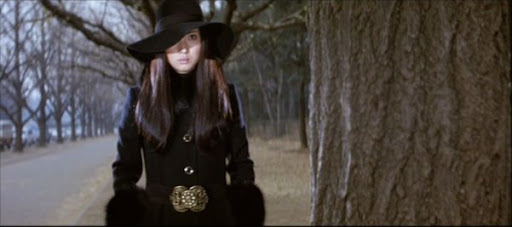
Technical Information:
Title: Female Convict Scorpion: Jailhouse 41 (Remastered)
Year: 1972
Country: Japan
Director: Shunya Itō
Source: Retail DVD5
DVD Format: NTSC
Container: .iso+mds
Size: 4.27 GB
Length: 1:33:32
Programs used: Subtitle Creator
Resolution: 720x480
Aspect Ratio: 16:9 Letterboxed
Video: MPEG2 @ ~4800 kb/s
Frame Rate: 29.97 fp/s
Audio: Japanese- Dolby AC3 Stereo @ 384 kb/s
Subtitles: English (Custom)
Menu: Yes
Video: Untouched
DVD Extras: Trailer
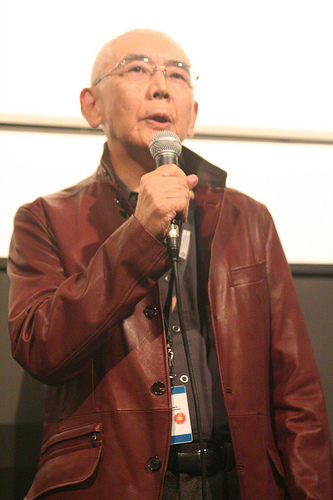
(Use JDownloader to automate downloading)
Female Convict Scorpion Megaupload Links
Labels:
DVD5,
movies,
shunya itō
Roald Amundsen- Roald Amundsens Sydpolsferd/Roald Amundsen's South Pole Expedition (1910-1912)- DVD Rip (480p-x264)

Here's another documentary of sorts - the complete footage from Norwegian explorer Roald Amundsen's expedition to the South Pole... and maybe some people (Leclisse) are right and I'm the only one in the world who thinks this is really frickin' cool, but Roald Amundsen is hardcore. He shakes a stick at a penguin and stabs a seal in the back.
Actually, I wouldn't be surprised if the site ends up covered in red paint (or human blood) over this one.
From the United Nations Educational, Scientific and Cultural Organization:
Roald Amundsen and his 4-man team reached the South Pole, with the help of polar dogs, on 14 December 1911. The expedition, and particularly the dog-sled journey to the Pole, is described as daring and with an exceptionally good logistic planning and execution.
The Antarctic and the Arctic Polar Regions, for several centuries, were regarded as the final frontiers for mankind to conquer, and the North and South Poles were for a long period of time the great goals to attain within geographic discovery.
The discoveries in the polar areas contributed, not least in Norway but also internationally, to greater consciousness of, and political interest in, questions concerning sovereignty and rights in these sea and land areas.
The original film material of Roald Amundsen’s South Pole Expedition documents a great historic achievement, outside the borders of the civilized world and in an extreme climatic environment.
In his time, Roald Amundsen (1872 – 1928) contributed, through several expeditions and together with his teams, to new knowledge within several aspects of polar research. First and foremost, however, he is remembered as a master of the classic polar expedition's planning and execution.
The film collection is unique, as it documents the important events of this first expedition to reach the South Pole. Though the material is incomplete, it is made up of original sequences, filmed between 1910 and 1912, consisting of negative film and first and second-generation print material.
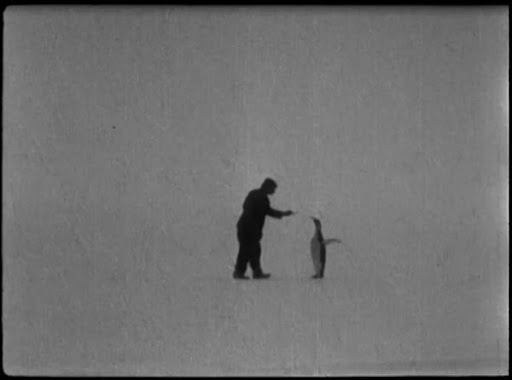
Technical Information:
Title: Roald Amundsens Sydpolsferd/Roald Amundsen's South Pole Expedition
Year: 1910-1912/2010
Country: Norway
Director: Roald Amundsen
Source: DVD9 Retail
Video Codec: 480p-x264
Container: .mkv
Size: 606 MB
Length: 41:23
Programs used: DVD Decrypter, Womble, RipBot
Resolution: 720x576
Aspect Ratio: 4:3
Video: AVC H264 @ 2048 kb/s
Frame Rate: 25 fps
Audio: None on source
Subtitles: None on source

Roald Amundsens Sydpolsferd Megaupload Link
Labels:
documentaries,
roald amundsen,
x264 doc
Kazuo Hara- ゆきゆきて、神軍/The Emperor's Naked Army Marches On (1987)- DVD5 (NTSC Format)

We've been sooooooooooooo backlogged recently that L&S and I have devolved into "screw it" mode (excuse the french...) and are posting things we've yet to view.
"But why leclisse? That seems a bit sloppy. Aren't you taking the chance that you might post something that doesn't meet your oh-so-high-standards?"
I don't care anymore. FUCK STANDARDS- NOW! STANDARDS ARE A ZIONIST PLOT!
Leclisse...is your up-coming Carlos Extravaganza getting to you? It seems to be getting to you...you're not an anti-Zionist, leclisse.
You're right. I might need a break. Here's some more excellent Kazuo Hara. I think.

From Lindsay Nelson at Midnight Eye:
Early on in Kazuo Hara's The Emperor's Naked Army Marches On, the protagonist, 62-year-old Pacific War veteran Kenzo Okuzaki, begins what appears to be a typical Japanese wedding speech. As the camera moves between the traditionally dressed bride and groom, their eyes downcast, the speaker lists the groom's university and place of work, then congratulates the couple on their union. And then, with the matter-of-factness that will become his defining characteristic in the film, Okuzaki mentions that he fired Pachinko balls at Emperor Hirohito, killed a real estate broker, and served more than thirteen years in prison. The groom also "fought against the establishment", and that's how the match was made. No one reacts adversely, and the next shot is of the groom singing, followed more speeches and shouts of "Banzai!" We have entered a world of outsiders, one where Japanese traditions still command respect, but where certain societal norms are clearly being ignored.
Director Kazuo Hara has made a career out of documenting the lives of those living outside Japan's notoriously conformist society. His Goodbye CP (Sayonara CP, 1972) dealt openly with cerebral palsy, while Extreme Private Eros: Love Song 1974 (Kyokushiteki erosu koiuta 1974, 1974) followed the exploits of his ex-lover, radical feminist Miyuki Takeda, as well as Hara's own relationship with his producer, who eventually became his wife. With The Emperor's Naked Army Marches On, Hara focuses on Pacific War veteran and anti-Emperor activist Okuzaki seeking explanations for the deaths of soldiers in his regiment that occurred after the war had officially ended. Okuzaki suspects that they were cannibalized, or killed by superior officers because of the cannibalism they had witnessed. The camera follows him as he seeks out former army officials and relatives of the deceased, frequently resorting to verbal and physical abuse in order to get answers from his less-than-forthcoming targets. Conclusive answers are never provided, but several former officers essentially admit to cannibalism, and to killing soldiers to cover up what they did.

The film is basically a series of very long conversations punctuated by Okuzaki's occasional eruptions of violence. The anguish of both the deceased's relatives and the perpetrators is palpable-the relatives want the truth, but the superior officers have become so accustomed to lying that they may no longer be able to distinguish truth from falsehood. Cannibalism is talked about in the same matter-of-fact tone as Okuzaki's violence; we learn that human meat was referred to as "pork" and that natives of New Guinea were referred to as "black pigs," while Allied soldiers were referred to as "white pigs." Okuzaki, one minute bowing and presenting a business card and the next wrestling older men to the ground, emerges as a man full of contradictions. He rails against the establishment for lying about wartime atrocities, but deceives his targets by having his wife and friend pose as relatives of deceased soldiers. He condemns the deaths of the soldiers but has no problem engaging in violence of his own. His violence is inexcusable, but it is also effective-superior officers who claim amnesia suddenly regain their memories when Okuzaki threatens to beat them up. He's far from admirable (or even likeable), but you find yourself wanting him to succeed in his quest for the truth.
Made in 1987, Emperor can be seen as a precursor to current trends in Japanese documentary cinema, which emphasizes a Spartan, no-frills camera style and low production costs. Like Tatsuya Mori's A and A2 and Yutaka Tsuchiya's The New God, Emperor is cheaply made, relying mostly on handheld camera footage. Clean, carefully-composed camera angles are dispensed with (the camera equipment and microphones frequently pop up in the frame). The tiny, cluttered spaces of Japanese homes and offices appear even bleaker in the absence of artistic lighting or framing. With little in the way of background music and a somewhat haphazard editing style, the audience is left with only the characters to focus on, which is exactly what Hara wants.

Hara's films frequently call into question the relationship between filmmaker, subject, and audience. Watching films such as Eros and Emperor, the viewer occasionally feels like a guilty participant in the events taking place on screen. In one agonizing scene in Eros, Hara films the birth of his own son in a house in Tokyo, with no doctors present. The baby is delivered unconscious, and for several minutes its limp body is washed, patted, and shaken upside down until finally, to the audience's intense relief, the infant begins to cry. In Emperor, Hara watches as Okuzaki kicks and attempts to strangle an elderly ex-army officer who has just had surgery, leading the victim to scream, "You just film it and do nothing?" Later, we learn that Okuzaki attempted to kill one official's son, which seemed to thankfully cause Hara to draw a line-the attempt was not filmed. The passive audience member watching such events becomes, inadvertently, a participant, while the ostensibly objective filmmaker could be accused of gross negligence.
The film also provokes plenty of laughter, though it's usually of the uncomfortable sort. When the relatives of the deceased soldiers decide that they no longer wish to accompany Okuzaki on his quest, Okuzaki doesn't give up. The scene in a pub where he calmly tells his wife and friend that they will "play" the roles of the relatives is priceless, as are subsequent scenes where the wife and friend sit mutely as Okuzaki tells army officers how much they have suffered. The bizarre way in which violence is threatened (Okuzaki politely tells one former officer that he came here planning to beat him up, but decided not to), as well as the bland way in which the potential victims respond, makes an uncomfortable situation unintentionally humorous. Even when violence happens, the ludicrousness of the situation (family members standing by politely saying, "No violence," Okuzaki offering to call the police himself, the inaction of the police when they do arrive) makes for funny, if still uncomfortable, scenes.

In the end, though, what we are seeing is essentially "real", which makes for uneasy viewing. By filming Okuzaki's violence and not intervening, does Hara condone his actions? Subsequently, does the watching audience also condone both Okuzaki and Hara's actions? At one point should the filmmaker cease to be objective and step in to influence the events he or she is filming, if ever?
In a 1993 interview with Dartmouth professor Jeffrey Ruoff, Kazuo Hara was quoted as saying that documentaries "should explore the things that people don't want explored." His own documentaries have become famous doing just that, and for displaying images that the public doesn't necessarily want to see. Though his inaction in the face of the violence and potential suffering that happens in front of his camera raises serious ethical questions, The Emperor's Naked Army Marches On should be applauded for its sheer audacity, and for the important questions it raises about the roles and responsibilities of filmmaker, audience, and subject.

Technical Information:
Title: ゆきゆきて、神軍/The Emperor's Naked Army Marches On
Year: 1987
Country: Japan
Director: Kazuo Hara
Source: DVD5 Retail
DVD Format: NTSC
Container: .iso + mds
Size: 3.27 GB
Length: 2:01:06
Programs used: Unknown
Resolution: 720x480
Aspect Ratio: 4:3
Video: MPEG2 @ ~3500 kb/s
Frame Rate: 29.97
Audio: Japanese- Dolby AC3 Stereo @ 192 kb/s
Subtitles: English
Menu: Yes
Video: Untouched
DVD Extras: None on source
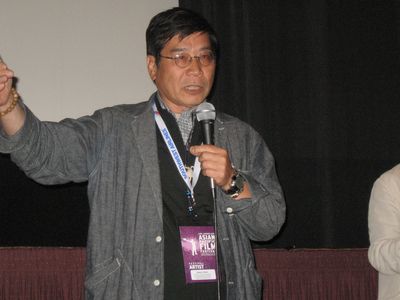
(Use JDownloader to automate downloading)
The Emperor's Naked Army Megaupload Links
Labels:
documentaries,
dvd doc,
kazuo hara
Book of the Month
This month,
EARTH (The Book)
By Jon Stewart and the Writers of The Daily Show
Like its hilarious predecessor, America (The Book), Earth is a satiric jaunt through our planet's history, biology and culture. The premise behind the book's existence is that it is a Frommer's guide book, of sorts, for alien visitors, the book being the only information source left after humanity has died out. Because humans have become all but extinct, the book is easy to read with lots of pretty pictures, diagrams and charts. If you read America, you'll be very familiar with the high school text book design, or if you went to high school and actually read any of your text books.
Those clever Daily Show folks nicely organized the books into easy to digest sections like- Earth, Man and The Life Cycle, while also including clever appendices with titles like, Why We're Not Here. This made me laugh the most as it included such possible reasons for our demise as Alien attack, natural disasters and genetically enhanced killer Bee Sharks. Don't get stuck in just one section of the book, though, because each chapter is loaded with funny little bits, right down to the smallest print.
Even though this book does a fabulous job of skewering everything we know down to the smallest detail, there is a twinge of sadness and nostalgia felt while reading because it does make you wonder about when and how we will ultimately destroy ourselves, and the planet. But then you flip to the page that has a picture of Larry King's penis, and you are jolted back into reality. After a thorough reading, I have no fear that any aliens, be they Vulcans, blue Avatar guys, or chest bursters, would be able to get the basics about the human race and this planet from Earth (The Book).
Labels:
Book of the Month,
Books
Various Artists- 極東最前線2/Kyokuto Saizensen 2 (2008)- CD Rip (FLAC)

After a futile search for the soundtrack to Sion Sono's Love Exposure (apparently no soundtrack was every released) led to an equally futile search for Yura Yura Teikoku's album Hollow Me/Beautiful (which is everywhere in mp3, nowhere in lossless), I eventually stumbled onto this 2 disc compilation of Japanese music, which isn't remotely what I was looking for, but is great nonetheless. Is there a Kyokuto Saizensen 1? Probably, although I haven't seen it. Are the translations of the song titles correct? I doubt it, but that's all google translator gave me. In any case, enjoy the music and if anyone has some lossless Yura Yura they'd like to share with me, it would be very much appreciated.

ゆらゆら帝国 (Yura Yura Teikoku)- タコ物語 (Story Octopus)- Live
Technical Information:
Artist: Various Artists
Album: 極東最前線2 / Kyokuto Saizensen 2
Year: 2008
Audio Codec(s): FLAC8
Encoding: Lossless
Rip: split tracks
Avg. bitrate:
Disc 1- 852 kb/s
Disc 2- 862 kb/s
Sample rate: 44100 Hz
Bits per sample: 16
Channels: 2
File size:
Disc 1- 360 MB
Disc 2- 419 MB
Length:
Disc 1- 0:59:05
Disc 2- 1:08:02

OWKMJ- 遊星からの物体X (Thing X)
Disc 1 Tracklisting:
01. Panicsmile- Western Development (4:18)
02. Toe- ラストナイト (Last Night) (5:02)
03. ゆらゆら帝国 (Yura Yura Teikoku)- タコ物語 (Story Octopus) (Live) (5:21)
04. 二階堂和美 (Nikaidou Kazumi)- あなたと歩くの (Walking with You) (4:23)
05. トクマルシューゴ (Shogu Tokumoru)- Micro Guitar Music (1:34)
06. Eastern Youth- 東京 (Tokyo) (5:02)
07. 枡本航太 (Wataru Hutoshi)- 蒼 (Blue) (5:02)
08. M.A.G.O.- アイオライト (Iolite) (4:57)
09. OWKMJ- 遊星からの物体X (Thing X) (4:45)
10. Facing New York- Heartbreak (2:55)
11. Sakerock- 七七日 (Seventy-seven Sun) (4:05)
12. Teasi- 遠足 (Excursions)
13. 54-71- Wrong Again (3:08)
14. Shonen Knife- Evil Birds (3:42)

Tucker- MeatBalls
Disc 2 Tracklisting:
01. Deerhoof- You Will Regret (2:55)
02. Zazen Boys- Amayadori (5:36)
03. Foul- Decade (4:18)
04. Tucker- MeatBalls (2:22)
05. Cursive- All I Know (3:15)
06. The Back Horn- 何もない世界 (There Is Nothing the World) (4:46)
07. 小谷美紗子 (Kotani Misako)- 東京~イースタン小谷.Ver.~ (Tokyo: Eastern Otari...) (6:22)
08. Miscorner- c+llooqtortion/of daybreak (4:36)
09. 手水- 夜を歩く (Walk the Night) (4:58)
10. Test Pattern- フィルムのかたち (Forms of Film) (4:55)
11. にせんねんもんだい- Efter God Mad (4:14)
12. Cock C'Nell- プレゼント (Present) (4:36)
13. Notalin's- アイウエオ (Aiueo) (4:53)
14. タテタカコ (Vertical Takako)- 季想 (Virtual Season) (5:16)
15. Envy- Fallen Fragments (5:00)
手水- 夜を歩く (Walk the Night)
Disc 1 Megaupload Link
Disc 2 Megaupload Link
Labels:
lossless cd,
music
Movie of the Week
This week,
RETURN OF THE JEDI (1983)
Starring- Mark Hamill, Harrison Ford, Carrie Fisher, Billy Dee Williams
Alright, my little Ewoks, I am going Star Wars on you for this week's movie. Thankfully, George Lucas had not yet become the world's greatest ruiner when he penned the final chapter in the Star Wars saga. Picking up where The Empire Strikes Back leaves off, Jedi reunites us with Luke and Co. as they try to rescue Han Solo (still frozen) from Jabba The Hutt back on Tatooine. Once they get Han back, (sorry if that spoiled anything) the story then turns to Luke's struggle to defeat Darth "Papa" Vader and the Emperor, while the rebels make a last ditch attempt to take out the new Death Star.
Rather than boring you with details from a movie that we all know so well, I will do what I did last time and give you my Top Ten favorite things about Episode VI.
10. Yoda's death. Sad and moving at the same time, but one wonders if he had been able to tell Luke more stuff before he died if he didn't say "Luke" at the start of every sentence. Think about it.
9. Nub Nub- the best Ewok song that is sadly cut out of the Special Edition. Thanks a lot, Lucas.
8. The Speeder Chase in the forest. Really ahead of its time and quite exciting.
7. The Max Rebo Band- outside of the Cantina Band they are Tatooine's most popular and highest rated music group. I smell a Grammy coming for Sy Snoodles.
6. Sarlak. If you had to live in a giant anus in the desert you'd be cranky too.
5. Force Lightning. It's so cool that you almost wish the Emperor got to finish frying Luke with it.
4. Admiral Ackbar's ability to sense a trap.
3. Just so you know I'm not going to put Ewoks on this list because they suck. I'm even going to waste this spot just to say how lame they are.
2. The fat, dirty guy with man boobs who lives down in the Rancor pit.
1. Slave Leia. Every nerd's greatest fantasy and the hottest space chick until that girl with three boobs from Total Recall came along.
That's the list. May the Force be with you.
Things to watch for-
Salacious Crumb
A young Warwick Davis (Willow) as Wicket the Ewok
Rebel Scum
Darth Vader is really an old white guy
"The Emperor is not as forgiving as I am."
Labels:
Movie of the Week,
Movies,
Star Wars
Funkadelic- Maggot Brain (1971)- 2005 Remaster- EAC CD Rip (APE/FLAC)

Timely Funkadelic as a side-dish for the Sweet Baadasssss...
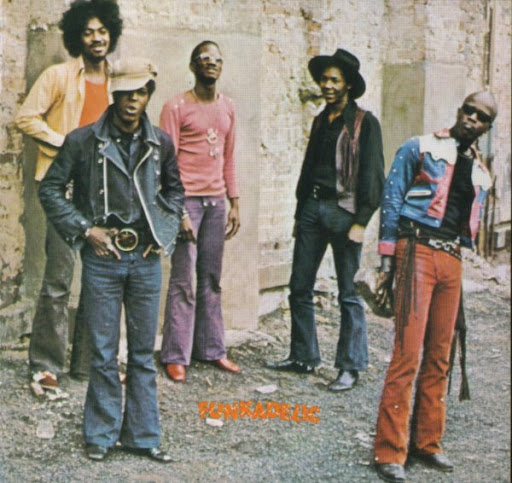
Can You Get To That
From the original liner notes:
'Fear is at the root of man's destruction of himself. Without Fear there is no blame. Without blame there is no conflict. Without conflict there is no destruction.
But there IS Fear: deep within the core of every human being it lurks like a monster; dark and intagible. Its outward effects are unmistakable. Its source is hidden.
It can even be seen on one level in furtive embarrassment, argumentative protest, social veneer and miserable isolation. It can be seen on another level in the mammoth build up of war machines in every corner of the world. It can be seen in the fantasy world of escapism known as entertainment. It can be seen in riot-torn streets and campuses. It can be seen in the squalor of ghettos and the pretentious elegance of 'civilised' society. It can be seen in the desperate rat race of commerce and industry, the sensational slanderings of the press, the constand back-biting of the political arena, and the lost world of the helpless junkie who has passed beyond the point of no return.
The tight-lipped wuppression of the rigid moralist reflects it, as does the violent protest of the anarchist. But more starkly and tragically than anywhere else, it manifests in the pale grey shadow of the ordinary person, whose fear clamps down on all his instincts and traps him in the narrow confines of the socially accepted norm. Afraid either to step down into the darkness of his lower self or to rise up into the light of his higher self, he hangs suspended in between, stultified into an alien pattern of nothingness.
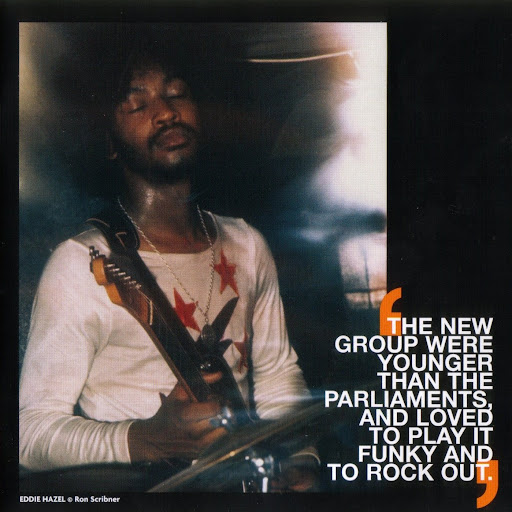
But to a greater or lesser degree, and manifesting one way or another, all human beings are afraid. And some of us are so afraid that we dare not show our fear. Sometimes we dare not even know our fear. For Fear itself is a terrifying concept to behold.
We may confess to being afraid of violence and pain, and even ghosts: and with such ovious terrors, pigeon-hole our fear to our own satisfaction. But fear of people, fear of ourselves, fear of failure, fear of loss, fear of our closest friends, fear of isolation, fear of contact, fear of loneliness, fear of involvement, fear of rejection, fear of commitment, fear of sickness, fear of deprivation, fear of intensity, fear of inadequacy, fear of emotion, fear of GOD, fear of knowlege, fear of death, fear of responsibility, fear of sin, fear of virtue, fear of guilt, fear of punishment, fear of damnation, fear of the consequences of our actions, and fear of our own fear? How many of us recognise the presence in ourselves of these?
And if some of us recognise some of them, are we prepared to see the full extent of them? Do we know just how afraid we are? And do we know the effect that our fear has on our lives? Do we know how completely we are foerned by our fear?
And do we know that the world is governed by the sum total of every human being's fear, and ours is not excluded?
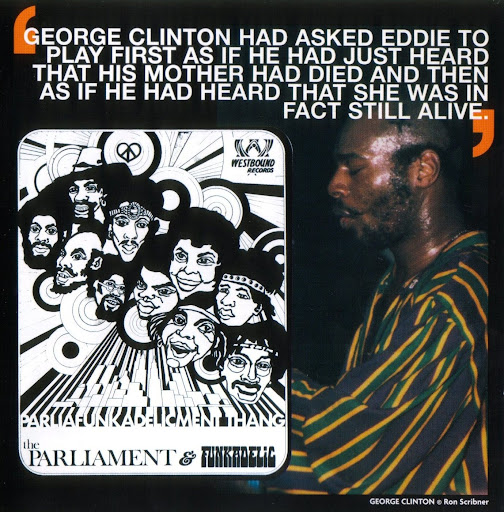
Do we know the extent to which we are at odds with one another - despite some promising apparencies - simply through our fear of one another? Do we know the extent to which we are at war with one another - on every level from personal to world wide - because we are afraid?
And do we know that wars and rumours of wars mount up in an ascending spiral of violence and potential iolence, as the fear in the hearts of men intensifies? Do we know that strife of every kind increases as hatred, resentment, jealousy and prejudice increase, and that all these stem from one thing only: Fear?
And do we know that one thing only ensures the escaltion of the spiral of violence and destruction, our own unwillingness to recognise the full extent of our fear and its effects - our fear of Fear?
For each and every one of us, as long as he is afraid, and unwilling to see with full clarity his fear for what it is, contributes to the crippling conflict that has become the hallmark of this world of ours. And as long as there IS fear, together with unwillingness to see it clearly and completely, as long as human beings are afraid and also fail t orecognise the fact in their need to isolate themselves, in their outbursts of anger and irritation, in their embarrassment, in their sense of failure, in their feelings of resentment and frustration, in their desire for revenge, in their guilt, in their confusion, in their uncertainty, in their disappointment, in their anxiety about the future and their wish to forget the past, in their need to blame others and justify themselves, in their sense of helplessness and despair, in their revulsion and disgust, in their need to be vicious and spiteful, in their lack of confidence, in their tendency to boast and protest their superiority, in their failure to respond, in their sense of inadequacy, in their feelings of engy, in their futility, in their misery and in their scorn: as long as human beings fair to see THEIR fear reflected in these and a hundred other manifestations of Fear, then they will fair to see their part in the relentless tide of hatred and violence, destruction and devastation, that sweeps the earth. And the tide will not ebb until all is destroyed.'
Taken from Process Number Five on Fear, The Process-Church of the Final Judgement.
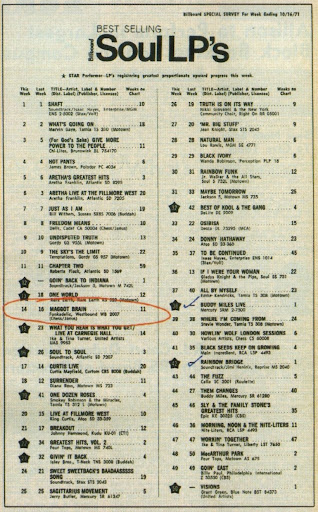
Technical Information:
Artist: Funkadelic
Album: Maggot Brain
Year: 1971
Audio Codec(s): APE/FLAC8
Encoding: Lossless
Rip: EAC APE + .cue/FLAC split tracks
Avg. bitrate: 838 kb/s
Sample rate: 44100 Hz
Bits per sample: 16
Channels: 2
File size: 324 MB/327 MB
Length: 0:54:06
Personnel:
Eddie Hazel: lead guitar, vocals
Tawl Ross: rhythm guitar, vocals
Bernie Worrell: keyboards, vocals
Billy "Bass" Nelson: bass, vocals
Tiki Fulwood: drums
George Clinton: vocals
Fuzzy Haskins: vocals
Calvin Simon: vocals
Grady Thomas: vocals
Ray Davis: vocals
Garry Shider: vocals
Tracklisting:
01. Maggot Brain (10:21)
02. Can You Get to That (2:52)
03. Hit It and Quit It (3:52)
04. You and Your Folks, Me and My Folks (3:38)
05. Super Stupid (4:01)
06. Back in Our Minds (2:41)
07. Wars of Armageddon (9:48)
08. Whole Lot of BS (2:13)
09. I Miss My Baby (with US Music) (5:05)
10. Maggot Brain (alternate) (9:36)
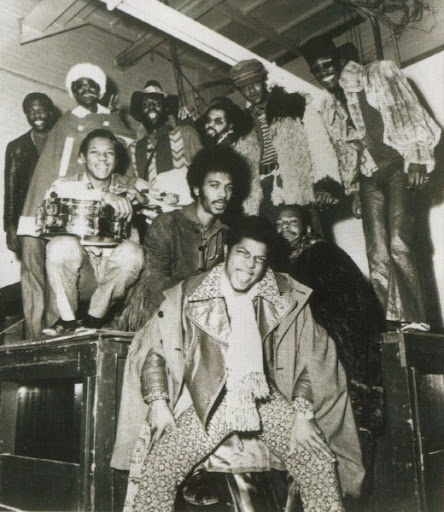
Maggot Brain Megaupload Links:
APE (img + .cue)
FLAC (split tracks)
Labels:
funkadelic,
lossless cd,
music
Melvin Van Peebles- Sweet Sweetback's Baadasssss Song (1971)- DVD5 (NTSC Format)

Here's some seminal black cinema from the early seventies. Where's the great black cinema today? The Hughes brothers with Book of Eli? Directors dressing in drag? Hmmmm...Spike Lee. Need to re-watch 25th Hour and Clockers I suppose.
These posts are from a jag that never quite happened last week, so bear with us. Times are hard, but this is a really great film. Enjoy.

From Richard Corliss at Time:
Liberation or exploitation? Radical politics or violent nihilism? Mature sexuality or child pornography? Modernist narrative or incoherent narrative? Trailblazer or piece of crap? Melvin Van Peebles' Sweet Sweetback answers to any and all of these descriptions. The Black Panthers made it mandatory viewing, while Ebony magazine denounced it. Moviegoers responded with cheers or outrage. And, frankly, I'm not taking sides.
But three matters are beyond debate: 1. It was like nothing seen before in a commercial movie house. 2. It instantly shifted the dominant tone of black films from liberal to anarchist, from uplifting message movies to fables of ghetto smarts and stickin' it to the man. 3. The movie was an out-of-nowhere hit, earning about $20 million on Van Peebles' personal $50,000 investment. Its success spawned a new and lasting genre: blaxploitation, with Superfly Black Caesar and Menace II Society and Bad Boys and dozen of others as its brawling progeny. All these factors make Sweet Sweetback, without question or competition, the most influential movie by a black filmmaker.

Van Peebles, a novelist who moved to France, where he directed and starred in the very genteel romance Story of a Three Day Pass, said he made Baad Asssss because he wanted to see a slice of black society, of black manhood, never, ever shown on the screen. Sweet Sweetback — his nickname is the ultimate compliment from one of his many bed partners — is not just an antihero, he's the anti-Sidney. To some blacks, the Poitier figure was a messiah of masochism, enduring insults from ignorant whites so that other whites, in the audience, would be convinced that he was superior enough to be allowed to buy a house next to them, He was Martin Luther King, Jr., to Sweetback's...whom? Not Malcolm X so much as Malcolm Little, the violent pimp who had to go to jail and be converted to Black Islam before he could preach his more elevated doctrine. Sweetback's message: If you want it, take it. If it feels good, do it. And if whites in the theater feel angered or threatened, who cares? Let them feel excluded from the movie, as blacks did from virtually every film made before this one.

Sweetback (played by Van Peebles, who also wrote, produced, directed, edited and scored the movie) is a sex hustler, and not one like the soulful yokel Joe Buck of Midnight Cowboy. Having sex for money doesn't demean him; it expresses him. At first he has an easy understanding with the police: they arrest him, he gets out. One night he agrees to be taken in just so they can make their quota. But on their way to the station, the cops pick up, then beat up, a black revolutionary. That sets Sweetback on his crimson revenge spree, and gets the cops to pursuing him in the chase that consumes the rest of the film. In structure, Sweetback is close to Native Son: ghetto guy is charged with an act of unpremeditated violence and goes on the run. The difference here: he gets away! The black man isn't killed for transgressing the white man's law. Even more improbably, Van Peebles got away with, profited greatly from, making this little Molotov cocktail of a movie.
And the child pornography? In an early scene we see a boy having sex with an adult woman. The kid was played by Van Peebles' son Mario, who seems to have survived OK. He became an excellent actor, and his first film behind the camera, New Jack City, is one of the most vivid and stylish directorial debuts I know.

Technical Information:
Title: Sweet Sweetback's Baadasssss Song
Year: 1971
Country: USA
Director: Melvin Van Peebles
Source: DVD5 Retail
DVD Format: NTSC
Container: .iso + mds
Size: 3.96 GB
Length: 1:37:01
Programs used: Unknown
Resolution: 720x480
Aspect Ratio: 4:3
Video: MPEG2 @ ~4200 kb/s
Frame Rate: 29.97 fps
Audio 1: English- Dolby AC3 Stereo @ 192 kb/s
Audio 2: English- Dolby AC3 5.1 @ 448 kb/s
Subtitles: None
Menu: Yes
Video: Untouched
DVD Extras:
- The Real Deal: What It Was... Is
- The Films of Melvin Van Peebles
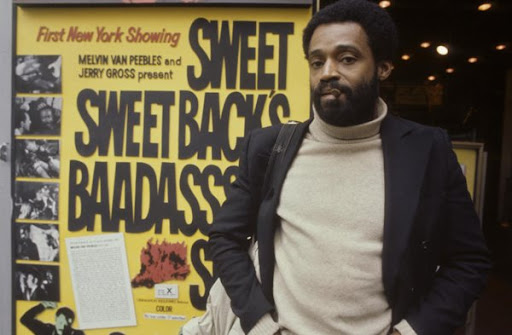
(Use JDownloader to automate downloading)
Sweet Sweetback's Megaupload Links
Labels:
DVD5,
melvin van peebles,
movies
The Greatest Rivalry
Forget Yanks/Sox or Duke/North Carolina, the greatest and most enduring sports rivalry is the Chicago Bears vs. the Green Bay Packers. Starting in 1921, these teams have met on the gridiron in many a hard hitting, muddy, snowy game that helped shape the modern NFL. Sunday, they will meet in the biggest and most important game in the long history of this rivalry. The winner of Sunday's game at Soldier Field will go to the Super Bowl.
The Packers last went to the big game in 1997, losing to the Denver Broncos. The Bears played in the Super Bowl more recently in 2007, but lost to the Indianapolis Colts. It would be huge for either team to make it to the championship, and that is why we will see what is likely to be the most hard-fought, knock down, drag out fight in either team's history. I have watched many a Bears/Packers game over the years, but have been underwhelmed by many of them because while they were fun games, none were for the right to advance to football's most coveted opportunity. Whatever happens on Sunday will be the culmination of the work of so many great Packers and Bears players that went at it over the past 90 years. Hallas, Lombardi, Lambeau, Butkus, Ditka, Hornung, Starr, Sayers, Payton, White, Singletary, Favre. Whose name will go to the top of this illustrious list with a win this weekend?
Woodson, Urlacher, Rodgers? Time will tell, I guess. I just hope to God it isn't Cutler. I don't like him.
(For maximum effect, read this while listening to the classic NFL Films song- A New Game)
Labels:
Football
Blurvana- Live at Breading- 08/30/1992- DVD9 (NTSC Format)
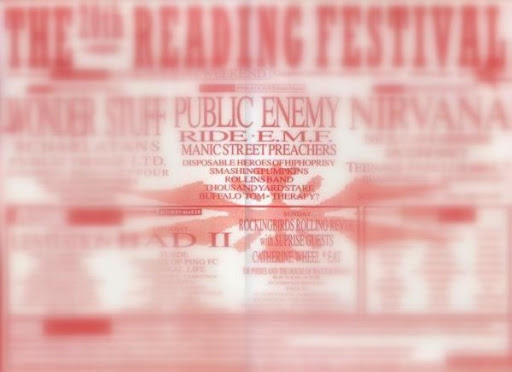
I've been meaning to re-up this ever since the links were pulled back in November (some 2 days after we posted it) and since I've spent a great deal of time disguising names and blurring out pictures and removing all traces that could lead anyone working for any particular record company to discover the identity of this band or the contents of this DVD, I have hopes that these links will stay up longer than the last set. As with all Blurvana, however, there are no guarantees and if you want it, you should get it quick before it disappears again.

From Anthony Lombardi at PopMatters:
Lord knows the last thing the music press needs is another tedious essay reiterating [Blu]rvana’s cultural impact and influence. During an era of pop music where backstory means nearly as much as the tunes presented with them, it’s tremendously refreshing to discover an album that not only lives up to the expectations heralded by its history, but supersedes them. The year was 1992, and [Blu]rvana were on top of the world—and we all know why, so I’ll save you the umpteenth recap of their meteoric rise and fall—when they took the stage to headline the [Br]eading Festival. Amid a plethora of rumors that entangled not only the band’s artistic avenues but [B]urt [B]obain’s personal life, to say that the Seattle trio had a great deal of baggage to overcome is a bit of an understatement. When it came time to sink-or-swim, not only did the world’s biggest band disprove any skepticism lingering on the tongues of their critics regarding their endurance, they shattered them entirely, playing with a reckless, utterly joyous abandon that does everything in its power to belie any notion that they were on the verge of a collapse.
Making his grand entrance slumped in a wheelchair and draped in a hospital gown, [B]obain thumbs his nose at the controversies enshrouding him and his band, cheekily downplaying the drama before diving headfirst into a surging “Breed” that sets the bar for the energy that throttles the band forward for the rest of the set. Given the tragedies that have inevitably marred [Blu]rvana’s legacy since [B]obain’s death, the sense of urgency and roaring ferocity that have forever acted as catalysts for their harrowing songs have often gone overlooked in favor of the romanticized, sensationalized pain and torment that’s easier read at face value. Here, that pulsing, beating heart—driven as much by bizarre humor and eccentricity as by suffering—is underscored through the band’s lively performance, their freewheeling tenacity gaining momentum as they tear through radio staples and buried treasures alike. What keeps this recording revelatory as well as exhilarating is how the band barely makes a distinction between the two, treating both fan favorites and rarities as one and the same as they jolt with ease from one highlight to the next, demonstrating with a ripping intensity how each song reveals a different, yet equally vital facet of [Blu]rvana’s character. The elating sense that these qualities, which too often feel like long-lost attributes of a truly exceptional band, feel like they’re being restored may be the most heartening thing about Live at [Br]eading.

While each era gets its time in the spotlight, the band are both wise and gutsy in dispensing with the hits halfway through the concert, allowing them the opportunity to not only trickle out a handful of In [Blu]tero cuts still due for release at the time, but also to accentuate their arty pranksterism in the process. [B]obain’s sense of pride beams through the Wipers and Fang covers that pummel out toward the end of the set, but he also bestows upon his audience the caustic, irreverent attitude that places spastic freak-outs like “Tourette’s” aside bubblegum strummers like “About a Girl”. By delivering so many contradictory motions in such a sputtering, erratic fashion, the band draws a portrait that not only tears down any criticisms leveled at them as one-trick ponies, but gives a well-rounded illustration of what a multi-dimensional group they were. Live at [Br]eading crystallizes a consummate moment in time, capturing [Blu]rvana just after the blow-up that [Bl]evermind sparked, yet just before that same impetus painted them into a corner. Here was a band pinned between two pillars of time, revolutionizing pop music while in the process of transcending the incendiary scene that propelled them to the forefront of the alternative rock phenomena.
It’s difficult to reason with the label’s decision to release the live compilation From the [B]uddy Banks of the [Bw]iskah in place of this era-defining document just following the height of [Blu]rvana’s cultural ubiquity. While the aforementioned disc caught in brief, brilliant flashes the character that helped [Blu]rvana conquer pop music in the 1990s, the [B]reading concert presents in complete, untainted glory the same inimitable nature that [B]uddy Banks came up short of relaying. Floating around as a bootleg since the show halted to a conclusion on the night of August 30th, this recording retains every bit of the soaring, raucous spirit that has procured its status as one of the great not-quite-lost yet not-quite-renowned gigs of rock and roll. It’s precisely that spirit that makes Live at [Br]eading a document not only worth preserving, but one that requires repeated return trips.

Technical Information:
Title: Blurvana: Live at Breading
Artist: Nirvana
Date: August 30, 1992
Location: Breading Festival, Breading, UK
Source: DVD9
Pro-shot: Yes
DVD Format: NTSC
Container: .iso + mds
Size: 7.08 GB
Length: 1:37:22
Programs used: ImgBurn
Resolution: 720x480
Aspect Ratio: 4:3
Video: MPEG2 @ ~8800 kb/s
Frame Rate: 29.97 fps
Audio 1: English- Dolby AC3 Stereo @ 192 kb/s
Audio 2: English- Dolby AC3 5.1 @ 448 kb/s
Audio 3: English- DTS 5.1 @ 1536 kb/s
Subtitles: None
Menu: Yes
Video: Untouched
DVD extras: None on source

Setlist:
01. Intro
02. Breed
03. Drain You
04. Aneurysm
05. School
06. Sliver
07. In Bloom
08. Come As You Are
09. Lithium
10. About a Girl
11. Tourette's
12. Polly
13. Lounge Act
14. Smells Like Teen Spirit
15. On a Plain
16. Negative Creep
17. Been a Son
18. All Apologies
19. Blew
20. Dumb
21. Stay Away
22. Spank Thru
23. Love Buzz
24. The Money Will Roll Right In
25. D-7
26. Territorial Pissings

(Use JDownloader to automate downloading)
Live at Breading Megaupload Links
Labels:
dvd live,
live performance,
music,
nirvana
Gordon Parks Jr.- Super Fly (1972)- DVD Rip (480p-x264)

We were planning "I-Wanna-Be-Black Week"...but it's already Wednesday. Oh well. Here's Superfly!

From Roger Greenspun at the New York Times (published 1972):
"Super Fly" is the story of Priest, a successful black New York narcotics dealer who decides to quit the business—and does it. To finance his retirement he means to deal $300,000 worth of cocaine into a $1-million profit, and so "Super Fly" belongs in the company of all those crime movies that have had as their subject the one big last job.
That it does not also belong with those movies portraying the evils of drugs, must be the result of very intelligent calculation; for there is no moralizing, not even the subtle silent kind, and the film's most eloquent spoken passage is given to Priest's partner when he defends dealing as a way of life.
"Super Fly" is almost exclusively an action movie, but with the distinction that all the action means something, and is not simply a lot of running or driving or flying around for the mechanical titillation of the customers. The film's gut pleasures are real, and there are a lot of them. But, they always connect with one another in a world so precisely, cruelly, excitingly balanced that there is no movement without countermovement, no pressure without a greater pressure in return.

It is a world of the most limited options—all leading to the question of being in or getting out. For Priest merely to win some time to make choices, he must engineer an escape that inevitably creates a prison for somebody else—the bad guy as it happens, the Man, the biggest dealer of them all. But a feeling for absolute and fateful interdependence has always been the special glory of the best crime movies. The world of "Super Fly" may be hell, but it also makes sense.
Tall, handsome, with flowing hair and coat, with flashing eyes, and with a gold cross around his neck that he uses to sniff his own cocaine, Priest must embody a lifetime of fantasies, with his mammoth car, his apartment downtown, his rich and elegant women. Ron O'Neal lives the part with a kind of furious authority that is sometimes excessive; more often expressive of a role that belongs as much to current myth as to reality. Carl Lee as his treacherous, timorous partner is even more impressive, partly because he speaks, whereas Priest mostly acts, and he happens to get the best lines.
It would be possible to fault "Super Fly" almost scene by scene for its minor blunders. As a director, Gordon Parks Jr. shares with his celebrated father a difficulty in managing simple exchanges between actors, a tendency sometimes to misjudge camera placement, an occasional weak reliance on handsome cinematography. But he has gotten so many more important things right and, in his first feature, he has made such a brilliantly idiomatic films, that it would be ridiculous to do less than praise him.
"Super Fly," a very good movie, opened yesterday at the Loew's State I and Loew's Cine theaters.

Technical Information:
Title: Super Fly
Year: 1972
Country: USA
Director: Gordon Parks Jr.
Source: DVD9 Retail
Video Codec: 480p-x264
Container: .mkv
Size: 2.34 GB
Length: 1:34:21
Programs used: RipBot, tsMuxer, SubRip, mkvmerge
Resolution: 720x480
Aspect Ratio: 16:9
Video: AVC H264 @ 2048 kb/s
Frame Rate: 29.97 fps
Audio 1: English- Dolby AC3 Mono @ 192 kb/s
Audio 2: French- Dolby AC3 Mono @ 192 kb/s
Audio 3: English Commentary- Dolby AC3 Stereo @ 192 kb/s
Subtitles: French, Spanish, cc-English
DVD Extras:
- One Last Deal: A Retrospective
- Ron O'Neal on the Making of Super Fly
- Behind the Threads and Behind the Hog
- Curtis Mayfield on Super Fly

(Use JDownloader to automate downloading)
Super Fly Megaupload Links
Labels:
gordon parks jr.,
movies,
x264 movies
Subscribe to:
Posts (Atom)







